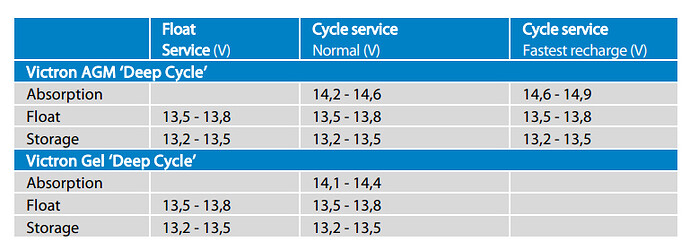Dear Community,
I am using MPPT 75/15 charger + AGM 12V 22Ah Deep Cycle battery for powering an external device which should run the whole year without any interruption. This 12V device has a power consumption of 0.8W. A 50W 12V Solar panel is used for charging.
The device, charger and battery is placed outdoors with temperatures ranging from -20°C to 35°C (air temperature, sun will warm up the battery housing).
I’d like to configure the MPPT 75/15 for maximum battery life. After reading about charging AGM batteries in general, I have the feeling that I should use the lower end voltages for Absorption, Float and Equalization, but am unsure. I also am unsure about which Battery Preset would be the best for maximum battery life. Could you share your experiences/insights about this?
A side question: Would another battery be better suited for this setup to maximise battery life?
Thanks & Best regards
Philipp
The usual advice is use the battery manufacturer’s recommendations. If you do not have these then Victron gel 1 is a good starting point at 14.3V / 13.8V with equalization disabled. As this will essentially be running in float most of the time, more like storage then reduce float in a user profile to circa 13.2V or 13.4V. Consider a Smart Battery Sense linked by VE Smart Network to the controller if it is a SmartSolar model to get proper temperature compensation.
Thanks for the quick reply! I didn’t explicitely mention that is is a Victron AGM Battery: BAT212200084.
So, “Victron Gel 1” and the lower ends of the voltages are sensible with the low consumption of my device?
Regarding the Smart Battery Sense: The battery and the MPPT 75/15 are in the same housing, only 10cm away from each other. The battery cables are only about 30cm long. Is a Smart Battery Sense still sensible in this setup or can it be omitted?
Thanks & best regards
The manual may have more details, my understanding is when the MPPT detects dawn from the rise in panel voltage, it reads an internal temperature sensor and uses that as the battery voltage for all day. This is because once the MPPT starts working and generating heat, the internal sensor may no longer be accurate for the battery temperature. If it is cold, the charge voltages are increased, so if the battery can warm up a lot during the day such as an outdoor installation then it may overcharge as it warms up. I think outdoor use is one case where better temp measurement is useful, same as batteries in an engine bay.
One thing AGM batteries do not like is being held at high voltage at high temperature and being overcharged.
You are right about the temperature measurement. As we can have very different temperatures troughout the day, I think the best solution really is to use the Smart Battery sense for a proper battery temperature reading. This can potentially increase the battery lifetime a lot in this outdoor setting.
So, I’d go for:
- proper battery temperature measurement to get a proper temperature compensation
- keep the voltage settings at the lower end for the battery
Any further thoughts on this?
What I found very little documentation about is the different presets (Victron Gel 1, Gel 2, AGM etc). Do they only change the settings visible in the UI or do they also effect other behaviours of the MPPT charger?
Thanks & best regards
They used to be listed in the manuals but do not appear to do so now. The best advice is to load the VicttonConnect app on your phone or computer and on the menu choose demo mode, then select your charger, then you can see the settings. The presets also change things like temperature compensation, equalisation, maybe absorption time as well as the voltages.
Nothing else to add re the set up.
I made these settings - I added my interpretation why it should increase battery lifetime in my screnario (small constant consumption). Feel free to comment/correct my assumptions:
- Set the absorption voltage to the lower end (14,2V for the Victron 12V AGM): This prevents the battery from being fully loaded (e.g. only 95% instead of 100%). Why does this increase battery life? I am not sure but read it

- Set the floating voltage to the lower end (13,5V): This stops the battery from being too frequently reloaded, leading to less cycles. Lesser cycles increase battery life.
- Add a Smart Battery Sense temperature sensor: This supplies the MPPT charger with correct temperature values. As my application is outdoors, the temperature differs a lot during a sunny day and the initial morning reading of the internal temperature sensor is not enough for correct voltage compensation. This could lead to too high voltages on hot days potentially damaging the battery.
- Set the correct temperature voltage compensation for the battery (in case of the Victron 12V AGM -24mV/°C according to the manual)
The 14.2V will still fully charge the battery, it just does it more slowly, so it stresses the battery less. Everything else should be OK.

